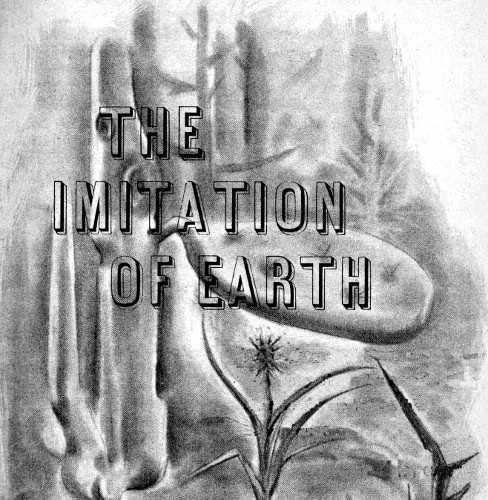
THE IMITATION OF EARTH
By JAMES STAMERS
Illustrated by CARTER
[Transcriber's Note: This etext was produced from
Galaxy Magazine October 1960.
Extensive research did not uncover any evidence that
the U.S. copyright on this publication was renewed.]

Once they had been human—now they shared a
remarkable destiny on an incredible new planet....
He was in some dark, moving medium which pressed him gently andreleased him and pressed against him again with irregular rhythm. Hecould not feel his hands. He could not feel any part of his body,except a sort of itching in his calf.
He thrust downward to relieve this mild irritation and, surprisingly,seemed to rise up. He seemed to be alive. He had no idea where, oreven when, or whether these were valid questions, for the ship hadbeen entering hyper-spacetime when they hit the asteroid belt. Warpsand elongations took place in hyper-spacetime. Perhaps he was now ahyper-spaceman.
He could recall his name. It was John Shepherd. He could rememberobjective events such as Doctor Adelitka Wynn creating a scene in theMars terminal bar. Her sociology was better than her sense, as sheaccused him of making a pass at her. He would have liked to, perhaps,but ship's etiquette said: "Crews date, captains wait, space is notthe place." He and she had been the last alive, and the last image hehad seen on the screen had been a sun. Whose sun, which sun, and wherewere just uninformed speculations. But he was alive and conscious ofhimself. And he was buried deep in something.
He tried to define his feelings.
The alternating pressure of the darkness was felt only in one spot,in the area of his heart and about the size of a small bean. Theoccasional itching came from below this. He thrust again and againrose upward. Yet he had no heart, or no sense of hearing, for he couldhear no sound of pumping. After several years in space he was only toofamiliar with the sound of his own blood circulating in his veins. Thevoids of space turned men into especially noisy bodily orchestras.There was none of that now.
He thought of himself as having the shape of a man, but perhaps thatwas just habit. The only area he could in fact feel was the beanslightly higher than his middle ... and a column perhaps attachinghim to the bean ... and this itching down below, in what seemed to beone doubled-up leg. He thrust again and again, rising higher eachtime. There was nothing else to do. He never felt tired. He never feltanything, except the itching.
Eventually he felt a slackening on the upward pressure. He had kickedwith his one leg, risen and found no resistance. Warmth played over himand he uncurled his head. So he had a head.
Habit had accustomed him to seeing with his eyes, from one set focalpoint. It was some time before he found he could see, in a general way,from any point on his exposed surface.
He could even see parts of himself, where the edges doubled over. Itwas like being able to run round a large gallery on the top of a dome,looking out at the view—and yet being the entire dome. He was green!He looked down beneath him and saw a long green pillar, tubular andshiny, rising out of a brown background.
He could still feel the beating pressure down below. It struck himthat he was a plant, growing from seed which presumably h